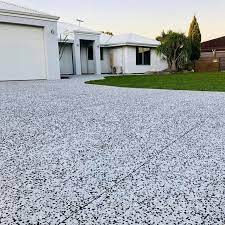Exposed aggregate offers a unique and textured finish to outdoor surfaces, and the choice of colors plays a crucial role in defining its aesthetic appeal. In this article, we’ll explore the world of exposed aggregate colors, popular choices, factors influencing color selection, installation tips, and the benefits of vibrant hues.
Exploring Exposed Aggregate Colors
Definition and Characteristics
Exposed aggregate involves revealing the natural beauty of stones within concrete surfaces. Colors are introduced through the choice of aggregates, influencing the final appearance. The characteristics of exposed aggregate colors range from subtle earthy tones to bold, eye-catching hues.
Importance of Color in Exposed Aggregate
Color is a key design element in exposed aggregate, influencing the overall look and feel of outdoor spaces. Whether complementing the landscape or making a bold statement, the right color choice enhances the visual appeal of exposed aggregate surfaces.
Popular Exposed Aggregate Colors
Earthy Tones
Earthy tones, such as browns, beiges, and greys, are popular choices for exposed aggregate. These colors seamlessly blend with natural surroundings, creating a harmonious and classic aesthetic that complements various landscapes.
Bold Hues
For those seeking a more vibrant and contemporary look, bold hues like blues, greens, or even reds can add a striking touch to exposed aggregate surfaces. These colors make a statement and work well in modern architectural settings.
Factors Influencing Color Choice
Landscape and Surroundings
The surrounding environment heavily influences color choices. Consider the colors of nearby plants, structures, and the overall landscape to ensure harmony between the exposed aggregate and its surroundings.
Architectural Style and Design
The architectural style and design of the property also play a role in color selection. Matching or contrasting with the building’s color palette can create a cohesive and visually pleasing outdoor space.
Benefits of Various Colors
Temperature Control
Light-colored exposed aggregate reflects more sunlight, helping to keep surfaces cooler in warmer climates. This can contribute to a more comfortable outdoor experience, especially during hot summer months.
Aesthetic Appeal
Different colors evoke different emotions and aesthetics. Earthy tones may create a tranquil and natural atmosphere, while bold hues add energy and modernity. The right color choice enhances the overall aesthetic appeal of outdoor spaces.
Choosing the Right Color
Sample Evaluation
Before finalizing a color, it’s advisable to evaluate samples in the actual outdoor setting. Natural light conditions and the surroundings can influence how colors appear, ensuring a more accurate representation of the final look.
Considering Maintenance
Certain colors may hide stains and discoloration better than others. Consider the ease of maintenance when choosing a color, especially in high-traffic areas or locations prone to spills.
Installation Tips
Proper Mixing and Application
Achieving consistent color in exposed aggregate requires proper mixing and application techniques. Follow manufacturer guidelines and consult with professionals to ensure an even distribution of aggregates and color.
Sealing for Color Longevity
Applying a quality sealer not only enhances the color but also protects it from UV rays and weathering. Regular resealing is essential to maintain the vibrancy of exposed aggregate colors over time.
Maintenance and Preservation
Routine Cleaning Tips
Routine cleaning is crucial for preserving the color of exposed aggregate surfaces. Regularly sweep or hose down the area to remove debris and prevent stains from settling.
Addressing Stains and Discoloration
For stubborn stains or discoloration, use a mild cleaning solution and a soft brush. Avoid harsh chemicals that could damage the color or the sealer. Seek professional advice for persistent issues.
Design Ideas
Mixing Colors for Unique Patterns
Experimenting with a mix of colors can create unique patterns and visual interest in exposed aggregate surfaces. Consider using contrasting or complementary colors for added design flair.
Integrating Colors with Outdoor Elements
Blend the colors of exposed aggregate with other outdoor elements. Coordinate with planters, furniture, or decorative features to create a cohesive and inviting outdoor space.
Cost Considerations
Initial Cost vs. Long-Term Value
While certain colors or aggregates may incur slightly higher initial costs, considering the long-term value and aesthetic enhancement can justify the investment in vibrant exposed aggregate colors.
FAQs
Can the Color of Exposed Aggregate be Changed Later?
Changing the color of exposed aggregate after installation is challenging. It’s advisable to carefully select the color during the planning stage to achieve the desired result.
Are Light or Dark Colors Better for Hotter Climates?
Light-colored exposed aggregate is generally better for hotter climates as it reflects more sunlight, contributing to cooler surfaces. Dark colors may absorb more heat, potentially making surfaces warmer.
Conclusion
In conclusion, exposed aggregate colors offer a spectrum of possibilities for enhancing outdoor spaces. Whether embracing earthy tones for a classic look or experimenting with bold hues for a modern aesthetic, the right color can transform your outdoor surfaces into vibrant and inviting areas.


